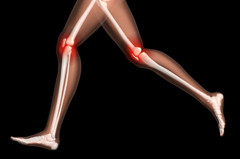Taking the pain out of runner’s knee

My left knee hurts. When I put weight on it with my leg bent, like when I get out of the car, I feel a dull pain in my knee. My doctor and physical therapist have given me a diagnosis of patellofemoral pain syndrome, also known as “runner’s knee” or patellar knee-tracking syndrome. Simply put, my kneecap doesn’t run smoothly up and down its track—a groove called the trochlea.
Anyone can get patellofemoral pain syndrome, but for some reason it is more common in women than men—especially in mid-life women who’ve been running for many years. The problem, say researchers who just published a study in the journal Gait and Posture, is that lots of “mature” women develop alignment problems with their knees. The researchers compared younger female runners to older female runners and found misalignment of the knee to be much more common in the older women. Some knees sagged inward, others bowed outward or were rotated.
When the alignment is off, the kneecap can’t smoothly follow its vertical track as the knee bends and extends. This causes wear and tear on the joint. That leads to overuse injuries like runner’s knee and, down the line, osteoarthritis, which can really put a cramp in a runner’s career.
My physical therapist recommended that I support my kneecap by strengthening my quadriceps (thigh) muscles and that I stretch the iliotibial band, a long band of connective tissue that runs from the knee to the hip. When that tendon is too tight, it pulls the kneecap off to one side. I also decided to vary my exercise routine. I haven’t stopped running, but I did cut back to three days a week. On the other days, I do yoga, weight training, or bicycle—anything to cut down on the repetitive force that running places on my knees.
You can look up this condition and other common knee-pain problems in Harvard’s Special Health Report, Knees and Hips: A troubleshooting guide to knee and hip pain. It describes the causes of different kinds of knee and hip pain and the array of treatments available. It also helps evaluate when the problem has become severe enough to warrant a knee or hip replacement. That’s something I hope to put off as long as possible.
About the Author

Kay Cahill Allison, Former Editor, Harvard Health
Disclaimer:
As a service to our readers, Harvard Health Publishing provides access to our library of archived content. Please note the date of last review or update on all articles.
No content on this site, regardless of date, should ever be used as a substitute for direct medical advice from your doctor or other qualified clinician.















